Balancing Emerging Risks Considering the Life-Cycle Perspectives of Submerged Floating Tunnels for a Resilient Future Infrastructure
Abstract
1. Introduction
2. Literature Review
2.1. Previous Studies on SFTs
- (a)
- SFTs with Pontoons
- (b)
- SFTs with Tethers
2.2. Life-Cycle Assessment
2.2.1. Methodologies
2.2.2. LCA Studies
2.3. Risk Assessment
3. Methodology
3.1. Step 1: Goal Identification for Conceptual Analysis
3.2. Step 2: Data Collection and Inventory Analysis
3.2.1. Quantification of Materials Based on Technical Design Drawings
3.2.2. Quantification of Environmental Impacts Based on the Materials
3.3. Step 3: Environmental Impact Assessment for Both Proposals
3.4. Step 4: Life-Cycle Analysis
3.5. Step 5: Threat Identification and Risk Assessment for Both SFTs
3.6. Step 6: Communicating the Combined Results
4. Case Study
4.1. Project Description
4.1.1. SFT with Pontoons
4.1.2. SFT with Tethers
4.2. Project Scope
4.3. LCA Analysis Inputs
4.3.1. Product Stage
4.3.2. Construction Stage
4.3.3. Use Stage
4.3.4. End of Life (EoL)
4.4. Risk Inputs
4.4.1. Hazard Identification
4.4.2. Risk Analysis
5. Results and Analysis
5.1. LCA
5.1.1. Production Stage
5.1.2. Construction Stage
5.1.3. End of Life (EoL)
5.2. Risk Assessment
5.2.1. SFT with Pontoons
5.2.2. SFT with Tethers
6. Discussion
- Carbon Emissions
- Risk Assessment
7. Conclusions
Author Contributions
Funding
Institutional Review Board Statement
Informed Consent Statement
Data Availability Statement
Acknowledgments
Conflicts of Interest
References
- IPCC. Climate change 2021—The Physical Science Basis. In Working Group I Contribution to the Sixth Assessment Report of the Intergovernmental Panel on Climate Change; United Nation: Geneva, Switzerland, 2021. [Google Scholar]
- UN Climate Change Conference. COP26 Goals. 2021. Available online: https://webarchive.nationalarchives.gov.uk/ukgwa/20230311034236/https://ukcop26.org/cop26-goals/ (accessed on 30 May 2023).
- European Commission. Energy Efficient Buildings. 2018. Available online: https://energy.ec.europa.eu/topics/energy-efficiency/energy-efficient-buildings_en (accessed on 1 July 2023).
- World Green Building Council. World Green Building Week 2019. Available online: https://worldgbc.org/ (accessed on 10 June 2023).
- Kaewunruen, S.; Sresakoolchai, J.; Yu, S. Global Warming Potentials Due to Railway Tunnel Construction and Maintenance. Appl. Sci. 2020, 10, 6459. [Google Scholar] [CrossRef]
- Moan, T.; Eidem, M.E. Floating Bridges and Submerged Tunnels in Norway—The History and Future Outlook; Springer: Singapore, 2019. [Google Scholar]
- Martire, G. The Development of Submerged Floating Tunnels as an Innovative Solution for Waterway Crossing; University of Naples Federico II Faculty of Engineering: Naples, Italy, 2010. [Google Scholar]
- Ministry of Transport. Norwegian Public Road Administration. 2008. Available online: https://www.regjeringen.no/en/dep/sd/organisation/subordinate-agencies-and-enterprises/norwegian-public-roads-administration/id443412/ (accessed on 4 August 2023).
- Baravalle, M.; Köhler, J. Risk and reliability based calibration of design codes for submerged floating tunnels. Procedia Eng. 2016, 166, 247–254. [Google Scholar] [CrossRef]
- BS EN ISO 14040:2006+A1:2020; Environmental Management—Life Cycle Assessment—Principles and Framework. BSI Standards Limited: Singpaore, 2020.
- Dossche, C.; Boel, V.; De Corte, W. Use of life cycle assessment in the construction sector: Critical review. Procedia Eng. 2017, 171, 302–311. [Google Scholar] [CrossRef]
- European Commission. Communication from the Commission on a Euprpean Programme for Critical Infrastructure Protection; Commission of the European Communities: Brussels, Belgium, 2006. [Google Scholar]
- Jiang, B.; Liang, B.; Wu, S. Feasibility study on the submerged floating tunnel in Qiongzhou strait, China. Pol. Marit. Res. 2018, 25, 4–11. [Google Scholar] [CrossRef]
- Østlid, H. When is SFT competitive? Procedia Eng. 2010, 4, 3–11. [Google Scholar] [CrossRef]
- Norwegian Ministry of Transport and Communications. National Transport Plan 2018–2029: A Targeted and Historic Commitment to the Norwegian Transport Sector; Storting (White Paper): Oslo, Norway, 2016. [Google Scholar]
- Fjeld, A. Feasibility Study for Crossing Sognefjorden-Submerged Floating Tunnel; Reinertsen Olav Olsen Group: Trondheim, Norway, 2012. [Google Scholar]
- Xu, W.; Ma, Y.; Liu, G.; Li, M.; Li, A.; Jia, M.; He, Z.; Du, Z. A review of research on tether type submerged floatin tunnel. Appl. Ocean Res. 2023, 134, 103525. [Google Scholar] [CrossRef]
- DByrne, M.; Lohman, H.A.C.; Cook, S.M.; Peters, G.M.; Guest, J.S. Life cycle assessment (LCA) of urban water infrastructure: Emerging approaches to balance objectives and inform comprehensive decision-making. Environ. Sci. Water Res. Technol. 2017, 3, 1002–1014. [Google Scholar]
- Butle, M.; Braet, J.; Audenaert, A. Life cycle assessment in the construction section: A review. Renew. Sustain. Energy Rev. 2013, 26, 379–388. [Google Scholar]
- Kohler, N.; Moffatt, S. Life cycle analysis of the built environment. Ind. Environ. 2003, 26, 17–21. [Google Scholar]
- Iversen, O.M.K. Early-Phase Life Cycle Assessment of New Concepts for Fjord Crossings along Coastal Highway Route E39; Norwegian University of Science and Technology: Trondheim, Norway, 2014. [Google Scholar]
- Kumar, R.; Bhowmik, R. Submerged floating tunnels: State-of-the-art on design and challenges. In Proceedings of the Indian Geotechnical Conference IGC 2022, Kochi, Indian, 15–17 December 2022. [Google Scholar]
- Xiang, Y.; Liu, C.; Zhang, K.; Wu, Q. Risk analysis and management of submerged floating tunnel and its application. Procedia Eng. 2010, 4, 107–116. [Google Scholar] [CrossRef][Green Version]
- The Constructor. Density of Construction Materials in kg/m3 and lb/ft3. 2016. Available online: https://theconstructor.org/building/density-construction-materials/13531/ (accessed on 30 July 2023).
- OGibbons, P.; Orr, J.J. How to Calculate Embodied Carbon. 2020. Available online: https://www.istructe.org/IStructE/media/Public/Resources/istructe-how-to-calculate-embodied-carbon.pdf (accessed on 20 June 2023).
- Hawwash, R. Safety, Risk and Hazard; University of Birmingham: Birmingham, UK, 2023. [Google Scholar]
- Dunham, K.K. Coastal Highway Route E39—Extreme crossings. Transp. Res. Procedia 2016, 14, 494–498. [Google Scholar] [CrossRef][Green Version]
- Vegvesen, S. Feasibility Study for Crossing the Sognefjord; Region West: Trondheim, Norway, 2012. [Google Scholar]
- Ayyad, S.M. Design Criteria for the Floating Walkways and Pontoons Considering the Extreme Climatic Conditions; Amman Arab University: Jordan, Arab, 2020. [Google Scholar]
- Kellenberger, D.; Althaus, H.-J.; Kunniger, T.; Lehmann, M.; Thalmann, P. Life Cycle Inventories of Building Products; Ecoinvent Data, Swiss Centre for Life Cycle Inventories: Geneva, Switzerland, 2007. [Google Scholar]
- RICS. Whole Life Carbon Assessment for the Built Environment. 2017. Available online: https://www.rics.org/globalassets/rics-website/media/news/whole-life-carbon-assessment-for-the--built-environment-november-2017.pdf (accessed on 28 June 2023).
- Haugerud, S.A. Personal Communication Regarding the Construction, Operation and Maintenance of the SFT Claimed Technically Feasible to Cross the Sognefjord. Personal E-mail Communication, 2024. [Google Scholar]
- Gunanandhini, T.; Sivakumar, S.; Sreenivasan, A.; Suresh, M. Green Construction Project Management: A Bibliometric Analysis. In ICT: Smart Systems and Technologies. ICTCS 2023. Lecture Notes in Networks and Systems; Kaiser, M.S., Xie, J., Rathore, V.S., Eds.; Springer: Singapore, 2024; Volume 878. [Google Scholar] [CrossRef]
- ISO 31000; ISO 31000:2018 Risk Management—Guidelines. International Organization for Standardization (ISO): Geneva, Switzerland, 2018.
- Hurlbert, M.; Krishnaswamy, J.; Johnson, F.X.; Rodríguez-Morales, J.E.; Zommers, Z. Risk Management and Decsion Making in Relation to Sustainable Development; IPCC: Geneva, Switzerland, 2019. [Google Scholar]
- Jakobsen, B. Design of the Submerged Floating Tunnel operating under various conditions. Procedia Eng. 2010, 4, 71–79. [Google Scholar] [CrossRef]
- Amdahl, J.; Ehlers, S.; Leira, B.J. Collison and Grounding of Ships and Offshore Structures; CRC Press: Trondheim, Norway, 2013. [Google Scholar]
- Matejicka, L.; Georgakis, C.T. A review of ice and snow risk mitigation and control measures for bridge cables. Cold Reg. Sci. Technol. 2022, 193, 103429. [Google Scholar] [CrossRef]
- Nadim, F. Landslide Hazard and Risk Assessment; United Nations Office for Risk Reduction (UNISDR): Geneva Switzerland, 2017. [Google Scholar]
- IGBC. IGBC Green New Buildings. 2020. Available online: https://igbc.in/igbc/redirectHtml.htm?redVal=showGreenNewBuildingsnosign (accessed on 10 June 2020).
- Thacker, S.; Adshead, D.; Fantini, C.; Palmer, R.; Ghosal, R.; Adeoti, T.; Morgan, G.; Stratton-Short, S. Infrastructure for Climate Action; UNOPS, UN Environment Programme (UNEP) and University of Oxford: Copenhagen, Denmark, 2021. [Google Scholar]
- Gijzel, D.; Bosch-Rekveldt, M.; Schraven, D.; Hertogh, M. Integrating Sustainability into Major Infrastructure Projects: Four Perspectives on Sustainable Tunnel Development. Sustainability 2019, 12, 6. [Google Scholar] [CrossRef]
- Hammervold, J.; Reenaas, M.; Brattebø, H. Environmental Life Cycle Assessment of Bridges. J. Bridg. Eng. 2013, 18, 153–161. [Google Scholar] [CrossRef]
- Mascella, M. Global Analysis of Submerged Floating Tunnels under Hydrodynamic Loading; Norwegian University of Science and Technology: Milano, Italy, 2020. [Google Scholar]
- Lee, H.K. Research Center for Smart Submerged Gloating Tunnel System; Korea Advanced Institute of Science and Technology (KAIST): Daejeon, Republic of Korea, 2018. [Google Scholar]
- Jonsson, D.K. Indirect energy associated with Swedish road transport. Eur. J. Transp. Infrastruct. Res. 2007, 7, 183–200. [Google Scholar] [CrossRef]
- Hoffmann, C.; Hoey, M.V.; Zeumer, B. Decarbonization Challenge for Steel. 3 June 2020. Available online: https://www.mckinsey.com/industries/metals-and-mining/our-insights/decarbonization-challenge-for-steel#/ (accessed on 14 August 2023).
- World Steel Association. World Steel in Figures; World Steel Association: Brussels, Belgium, 2023. [Google Scholar]
- Lunniss, R.; Baber, J. Immersed Tunnels, 1st ed.; CRC Press: Boca Raton, FL, USA, 2013; pp. 1–483. [Google Scholar]
- Swaalf, F. Reliability Analysis of Submerged Floating Tunnels; Delft University of Technology: Delft, The Netherlands, 2020. [Google Scholar]
- Civil Engineering Seminar. Submerged Floating Tunnel. 2016. Available online: http://civilenggseminar.blogspot.com/2016/06/submerged-floating-tunnel.html (accessed on 15 August 2023).
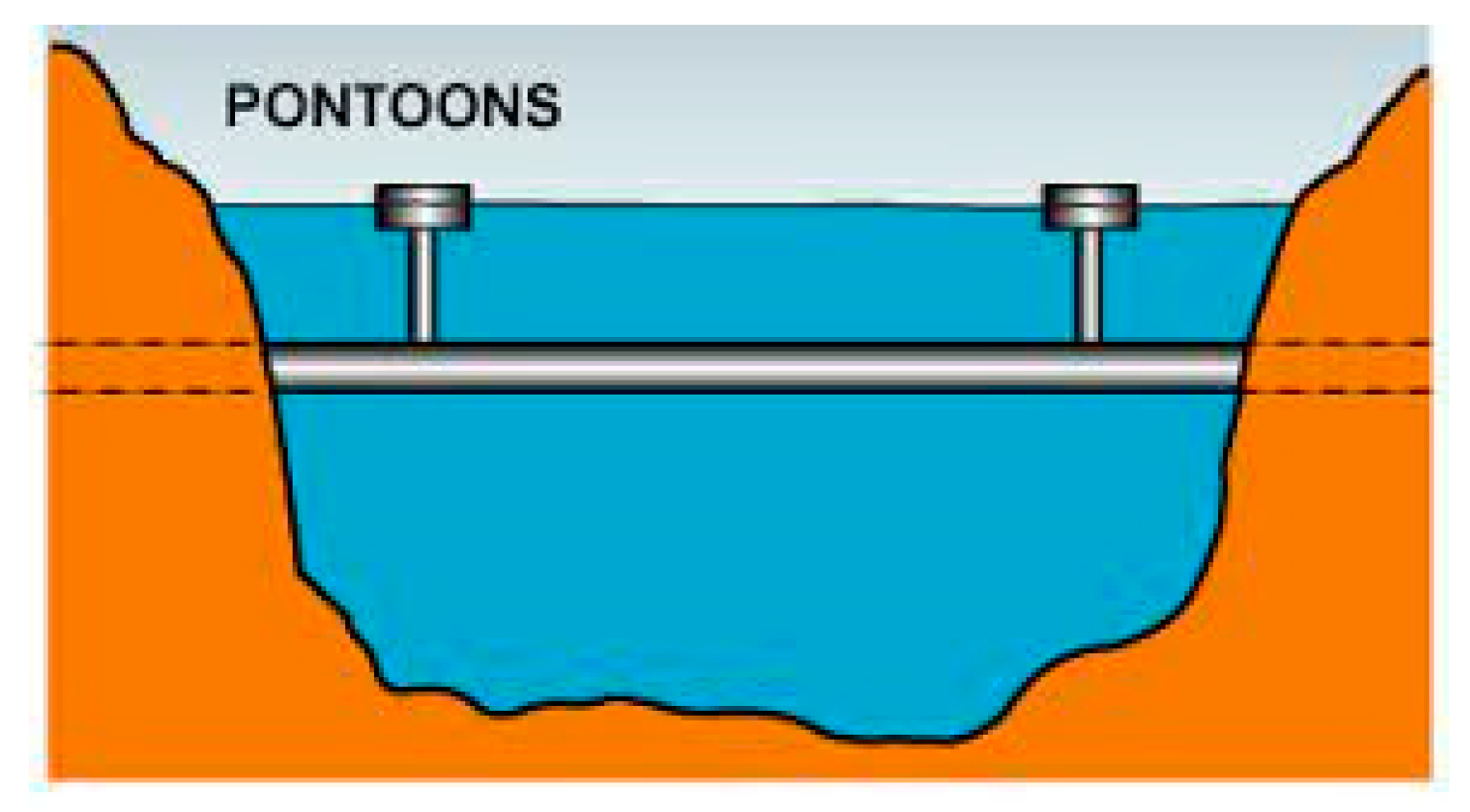

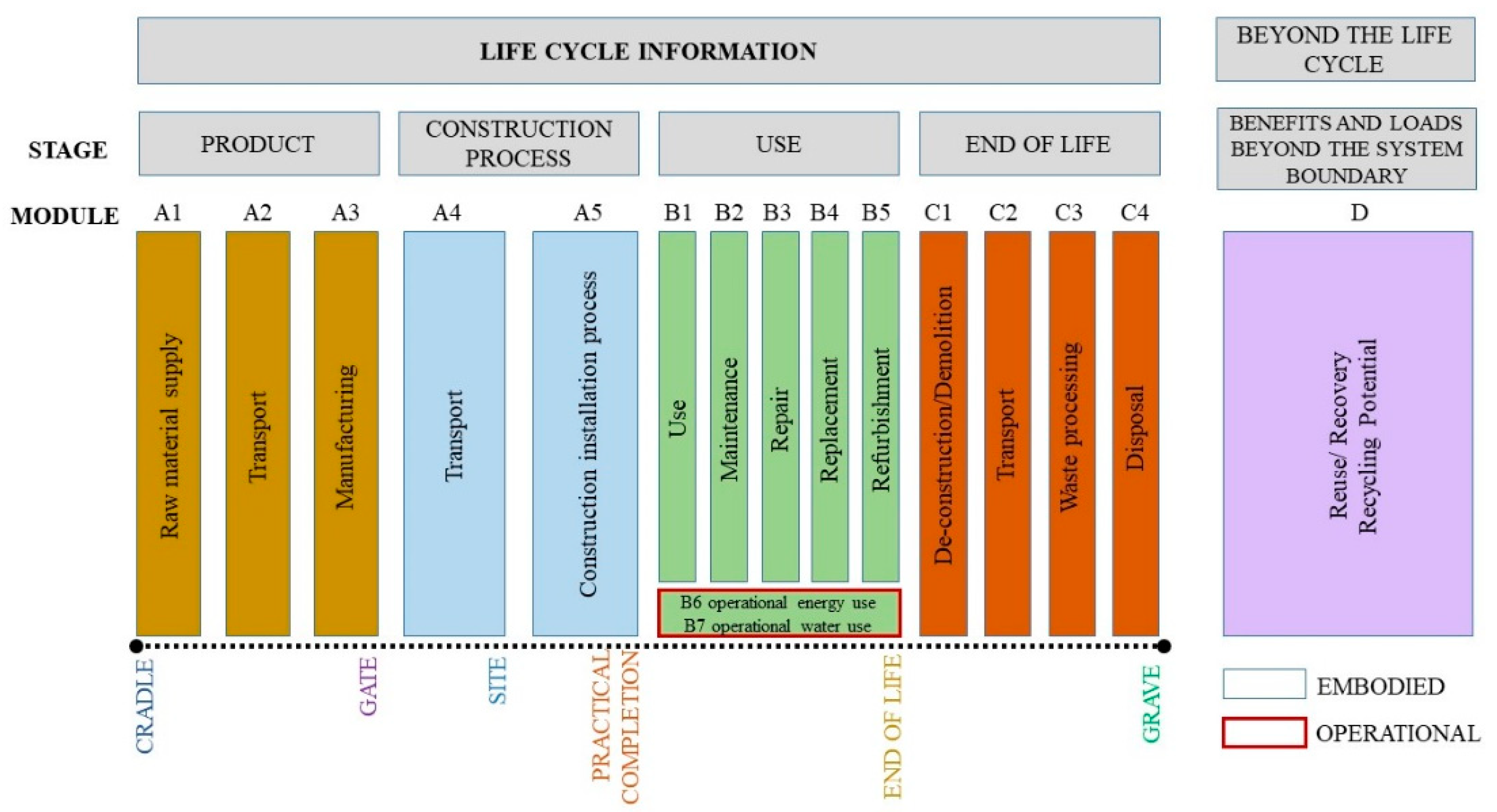


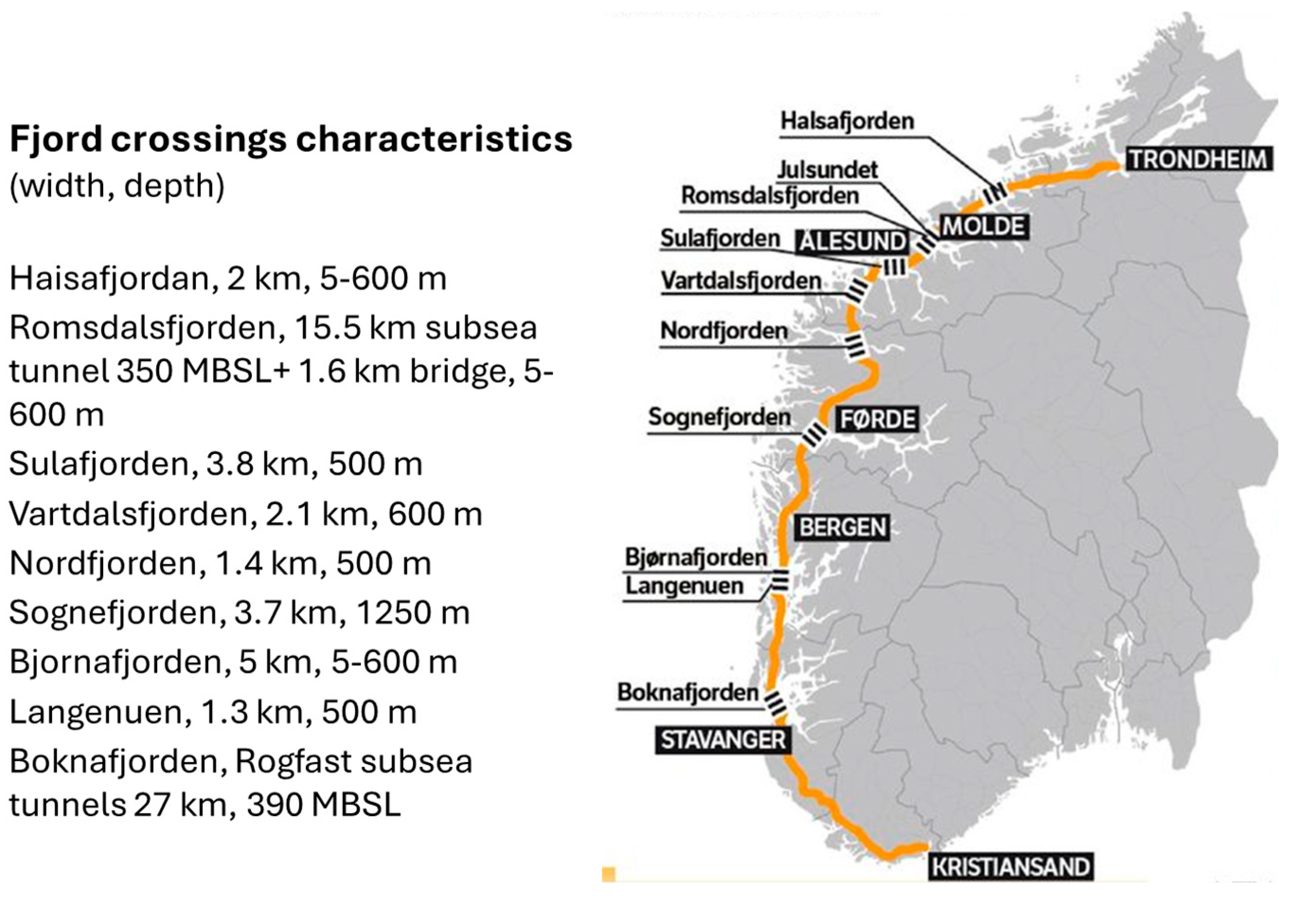
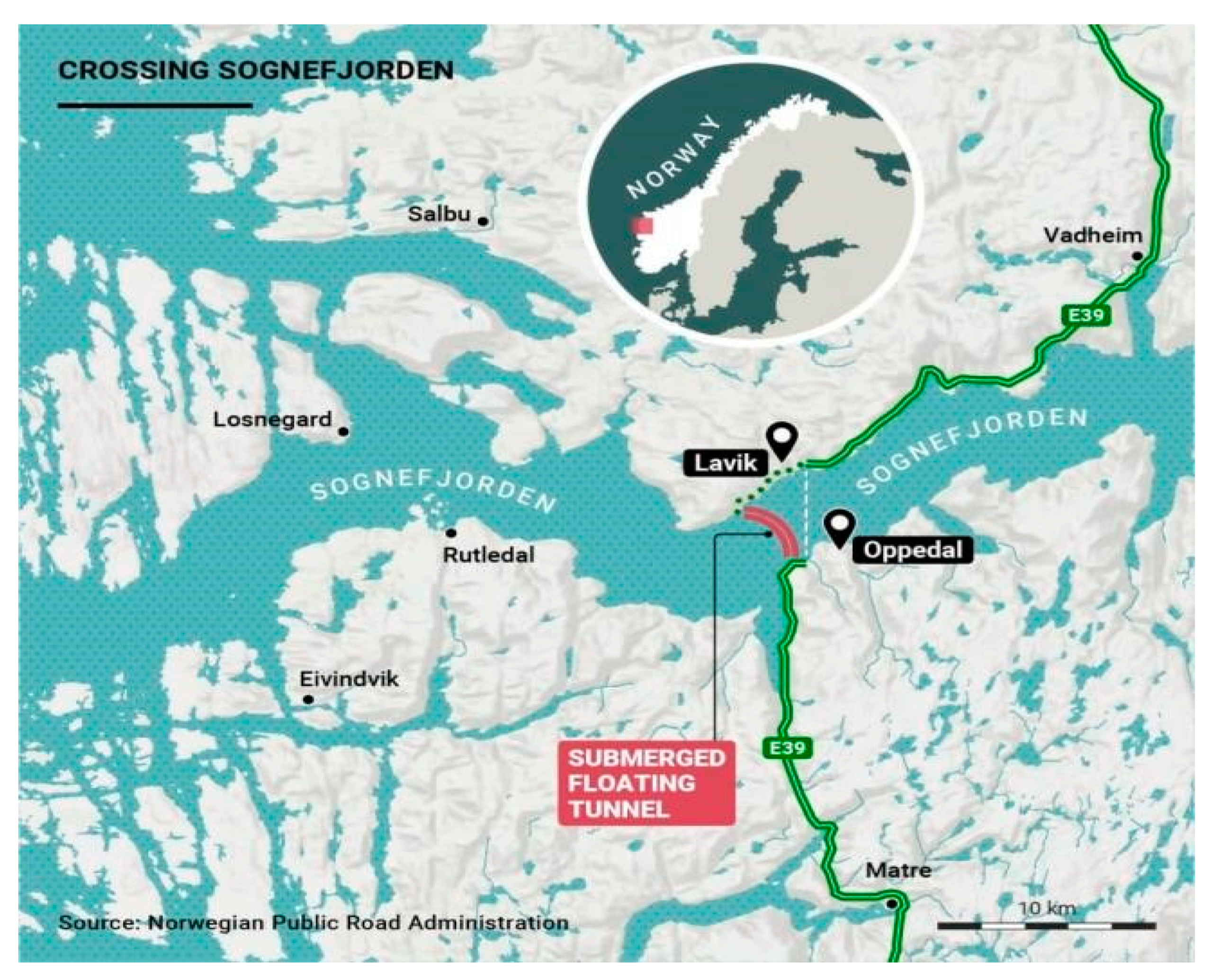

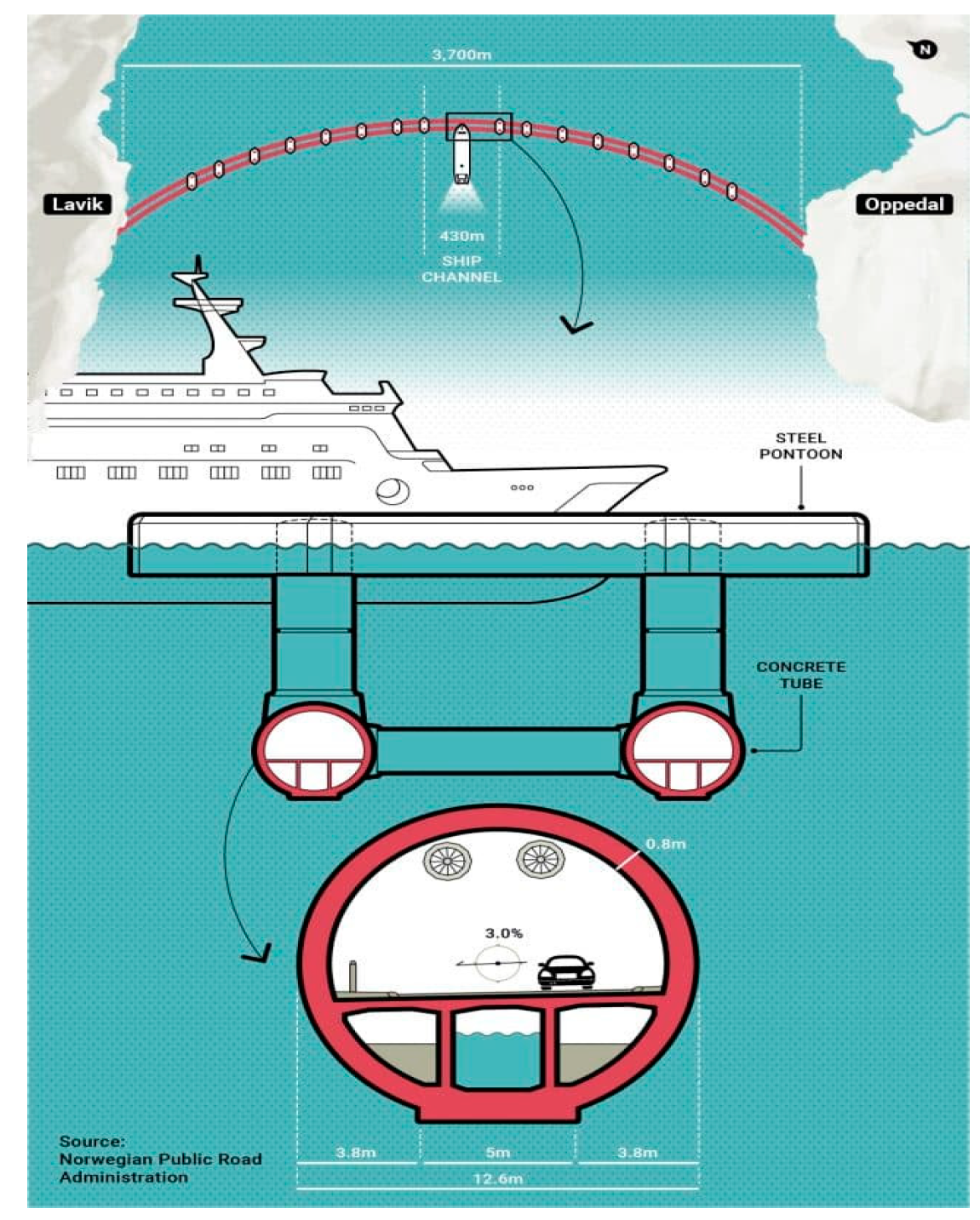



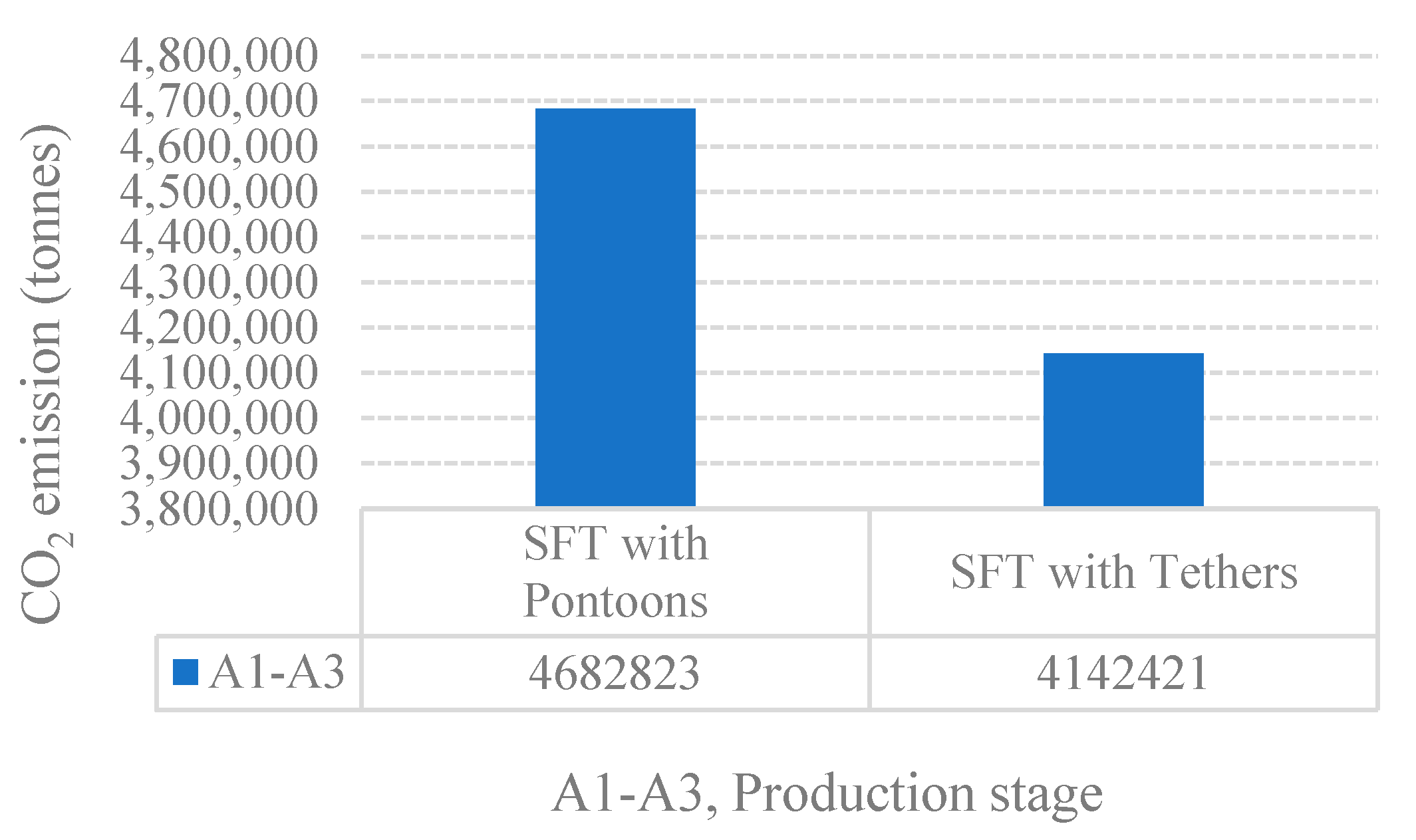



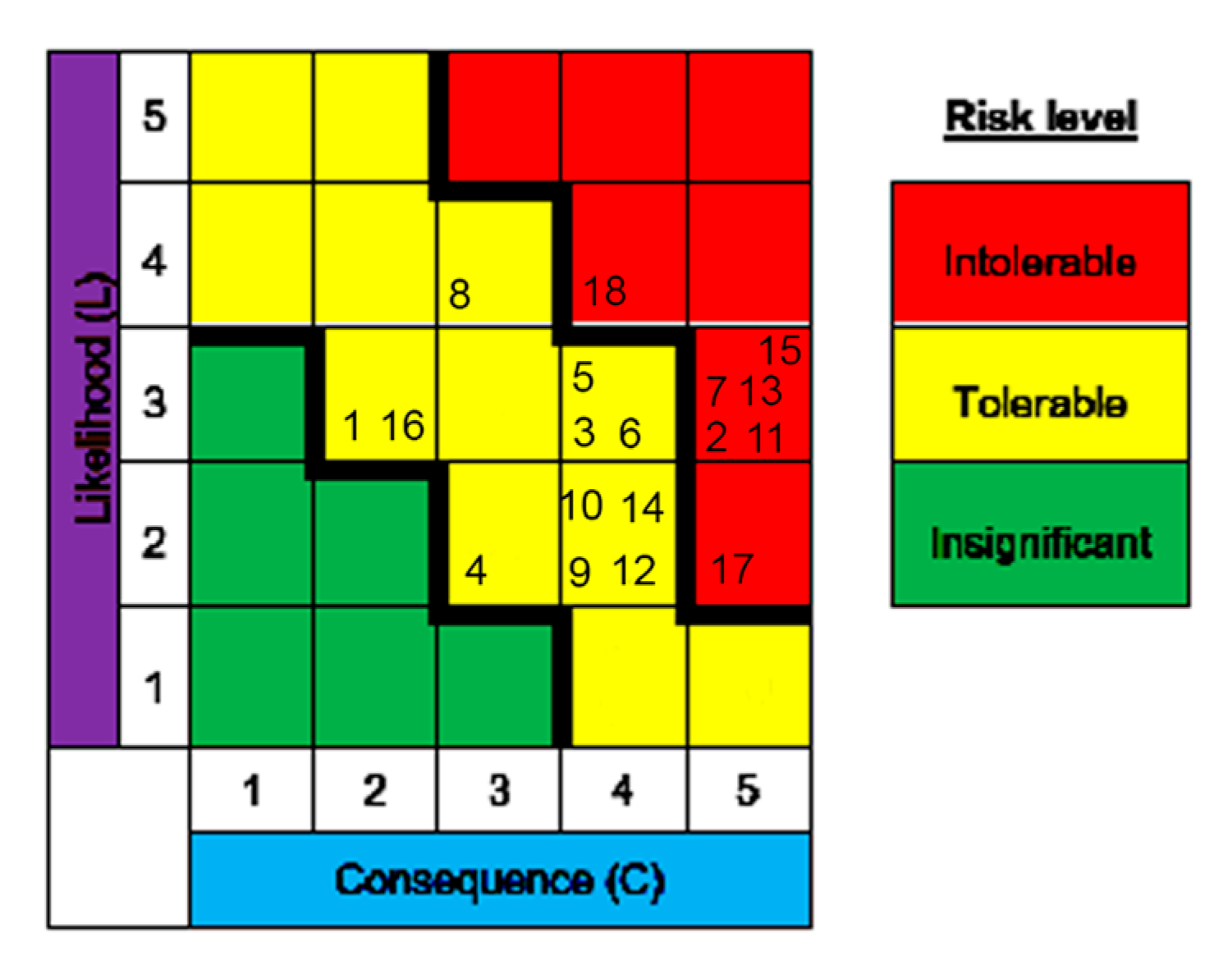



| Hazard |
|---|
| 1. Inadequate environmental impact assessment [33,34,35,36,37,38] |
| 2. Inadequate structural calculations, waterproofing design |
| 3. Accidents during construction [34] |
| 4. Failure of construction equipment |
| 5. Unidentified objects while placing the pontoons and tubes |
| 6. Inaccurate alignment and dimension deviation of the tube and landfall joint |
| 7. Inadequate connection between shaft, bracings, and pontoons during the assembly stage |
| 8. Construction delays due to bad weather conditions |
| 9. Landfall degradation |
| 10. Failure of tugs [21] |
| 11. Fire in the tunnel tube [21] |
| 12. Maloperation of ballast system [21] |
| 13. Pontoon and ship collision |
| 14. Power supply failure |
| 15. Leakage, influx of water in the tube |
| 16. Wear and tear of the pontoons |
| 17. Overload on pontoons |
| 18. Corrosion to pontoons and shafts |
| Hazard |
|---|
| 1. Inadequate environmental impact assessment [33,34,35,36,37,38] |
| 2. Inadequate structural calculations, waterproofing design |
| 3. Accidents during construction [34] |
| 4. Failure of construction equipment |
| 5. Unidentified objects while placing the tethers and tubes |
| 6. Inaccurate alignment and dimension deviation of the tube and landfall joint |
| 7. Inadequate connection between shaft, bracings, and tethers during assembly stage |
| 8. Construction delays due to bad weather conditions |
| 9. Landfall degradation |
| 10. Failure of tugs [21] |
| 11. Fire in the tunnel tube [21] |
| 12. Maloperation of ballast system [21] |
| 13. Power supply failure |
| 14. Leakage, influx of water in the tube [17] |
| 15. Wear and tear of steel tethers |
| 16. Overload on tethers |
| 17. Corrosion to tethers |
| Hazard | SFT with Pontoons | Mitigation | SFT with Tethers | Mitigation | Option with Lower risk |
|---|---|---|---|---|---|
| Rising water level [34] | Moderate risk due to potential buoyancy changes | Ballast systems should be adjusted to account for the risk | High risk compared to pontoons as water would try to lift the force upwards causing failure of the anchorage | Tether tension should be checked on a regular basis | SFT with Pontoons |
| Tsunami [17] | Large waves changing buoyancy pose a high risk | Pontoons should be built to withstand large wave forces and have emergency detaching systems | Tethers may be influenced by strong underwater currents, posing a moderate risk | Tethers should be reinforced and designed to allow for some mobility | SFT with Tethers |
| Storm [34] | Wave movement poses a high risk to pontoons | Pontoons should be aerodynamic and have a low wave impact | Because tethers are submerged, they are less vulnerable to surface storms | Ensure tethers are robust enough to withstand underwater currents | SFT with Tethers |
| Ice Formation [36] | Ice can impair buoyancy and movement, posing a high risk | Use ice-resistant materials and put ice-breaking systems in place | Tethers are less likely to be damaged by ice development because they are underwater | Allow for minor mobility; utilize ice-resistant materials | SFT with Tethers |
| Land Formation [37] | Landslides can produce waves that influence pontoon stability | Early warning systems and monitoring of surrounding land | Tethers might be less affected by waves caused by landslides due to their submerged nature | Create anchor points that can endure movements | SFT with Tethers |
| Earthquake | Risk of structural damage during seismic events | Incorporate flexible materials and seismic dampers in pontoon design | Design tethers to withstand seismic forces and allow flexibility | Incorporate flexible materials and seismic dampers in tether design | unpredictable |
Disclaimer/Publisher’s Note: The statements, opinions and data contained in all publications are solely those of the individual author(s) and contributor(s) and not of MDPI and/or the editor(s). MDPI and/or the editor(s) disclaim responsibility for any injury to people or property resulting from any ideas, methods, instructions or products referred to in the content. |
© 2024 by the authors. Licensee MDPI, Basel, Switzerland. This article is an open access article distributed under the terms and conditions of the Creative Commons Attribution (CC BY) license (https://creativecommons.org/licenses/by/4.0/).
Share and Cite
Velde, S.; Sresakoolchai, J.; Kaewunruen, S. Balancing Emerging Risks Considering the Life-Cycle Perspectives of Submerged Floating Tunnels for a Resilient Future Infrastructure. Sustainability 2024, 16, 5596. https://doi.org/10.3390/su16135596
Velde S, Sresakoolchai J, Kaewunruen S. Balancing Emerging Risks Considering the Life-Cycle Perspectives of Submerged Floating Tunnels for a Resilient Future Infrastructure. Sustainability. 2024; 16(13):5596. https://doi.org/10.3390/su16135596
Chicago/Turabian StyleVelde, Shweta, Jessada Sresakoolchai, and Sakdirat Kaewunruen. 2024. "Balancing Emerging Risks Considering the Life-Cycle Perspectives of Submerged Floating Tunnels for a Resilient Future Infrastructure" Sustainability 16, no. 13: 5596. https://doi.org/10.3390/su16135596
APA StyleVelde, S., Sresakoolchai, J., & Kaewunruen, S. (2024). Balancing Emerging Risks Considering the Life-Cycle Perspectives of Submerged Floating Tunnels for a Resilient Future Infrastructure. Sustainability, 16(13), 5596. https://doi.org/10.3390/su16135596







